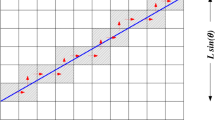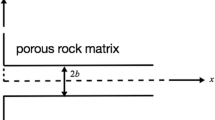Abstract
A stochastic discrete-fracture model was used by Cacas et al.a,b to interpret flow measurements and transport experiments in a fractured crystalline rock mass at Fanay-Augères. They considered continuum models to be incapable of properly interpreting small-scale measurements or tracer tests in fractured systems, which, in their view, require three-dimensional modeling of numerous discrete channels; in their opinion, continuum modeling applies only to average flow on a relatively large scale. Cacas et al. considered their discrete fracture model to have been validated by its demonstrated ability to reproduce selected experimental results. In this paper, flow and transport at Fanay-Augères are modeled by viewing the fractured rock as a stochastic continuum in a manner originally proposed by Neumanc,d. The stochastic continuum approach obviates the need for detailed information about fracture geometry or assumptions about how individual fractures control flow and transport. All it requires is the delineation of a few dominant features, which can be embedded into the stochastic continuum model as heterogeneous porous slabs. Though a fault zone has been identified at the Fanay-Augères experimental site, it has been modeled neither by Cacas et al. nor in this paper. In fact, in this paper, a larger selection of experimental results than those considered by Cacas et al. are reproduced merely by modeling the rock as a statistically homogeneous continuum in two dimensions. These results demonstrate that a continuum approach may be well suited for the analysis of flow and transport in fractured rock. This does not constitute a validation of the continuum approach, just as the results of Cacas et al. fall short of validating the discrete fracture approach. Instead, the two sets of results illustrate jointly the well-established principle that an open system, especially one as complex as fractured hydrogeologic environments tend to be, cannot be described uniquely on the basis of sparse data and need not be described in great detail to capture its salient behavior by a model.
Résumé
Un modèle stochastique de fractures discrètes a été utilisé par Cacas et al.a,b pour interpréter les mesures d'écoulement et les expériences de transport dans un massif cristallin fracturé de Fany-Augères (France). Les auteurs considéraient que des modèles à continuum sont incapables d'interpréter correctement des mesures ou des essais de traçage à petite échelle dans les systèmes fracturés, ce qui nécessite, selon eux, une modélisation en trois dimensions de nombreux conduits discrets; d'après eux, la modélisation par un continuum s'applique seulement à un écoulement moyen à une relativement large échelle. Cacas et al. considéraient que leur modèle de fractures discrètes avait été validé par sa capacité démontrée à reproduire des résultats expérimentaux sélectionnés. Nous avons modélisé l'écoulement et le transport à Fanay-Augères en représentant la roche fracturée comme un continuum stochastique d'une façon originalement proposée par Neumanc,d. L'approche par continuum stochastique évite le recours à des informations détaillées sur la géométrie des fractures ou à des hypothèses sur la manière dont les fractures contrôlent l'écoulement et le transport. Tout ce dont on a besoin est la définition de quelques faits dominants, qui peuvent être introduits dans le modèle stochastique à continuum comme des plaques poreuses hétérogènes. Bien qu'une faille ait été identifiée sur le site expérimental de Fanay-Augères, elle n'a été modélisée ni par Cacas et al., ni par nous. En fait, nous sommes capables de reproduire une plus large sélection de résultats expérimentaux que ceux considérés par Cacas et al., en modélisant la roche comme un continuum statistiquement homogène à deux dimensions. Nos résultats démontrent que l'approche par un continuum peut être bien adaptée à l'analyse de l'écoulement et du transport en roche fracturée. Ceci ne constitue pas une validation de l'approche par continuum, de même que les résultats de Cacas et al. n'arrivent pas à valider l'approche par fractures discrètes. En revanche, les deux jeux de résultats illustrent conjointement le principe bien établi qu'un système ouvert, particulièrement un système aussi complexe que tendent à être les environnements hydrogéologiques fracturés, ne peut pas être décrit uniquement sur la base de données éparses et ne nécessite pas d'être décrit en détails pour rendre compte des traits marquants de son comportement par un modèle.
Resumen
Cacas et al.a,b utilizaron un modelo estocástico de fracturas discretas para interpretar medidas de flujo y transporte recogidas en experimentos realizados en un macizo de rocas cristalinas fracturadas de Fanay-Augères (Francia). Los autores consideraron que los modelos continuos eran incapaces de representar adecuadamente medidas a pequeña escala o ensayos de trazadores en sistemas fracturados, para lo que estimaban necesaria la modelación tridimensional de numerosos canales discretos. En su opinión, los modelos continuos sólo son aplicables para flujos promedio a una escala relativamente grande. Cacas et al. consideraron que su modelo de fracturas discretas había sido validado por su capacidad demostrada para reproducir resultados experimentales seleccionados. Nosotros modelamos el flujo y el transporte en Fanay-Augères mediante la simulación de la roca fracturada como un continuo estocástico según la forma originariamente propuesta por Neumanc,d. El enfoque del continuo estocástico obvia la necesidad de disponer de información detallada de la geometría de las fracturas o de hipótesis sobre la forma en que fracturas individuales controlan el flujo y el transporte. Todo lo que requiere este enfoque es la delineación de unas pocas fracturas dominantes, que pueden ser embebidas en el modelo continuo estocástico como porciones porosas heterogéneas. Aunque se ha identificado una zona de falla en el emplazamiento experimental de Fanay-Augères, ésta no ha sido explícitamente modelada ni por Cacas et al. ni por nosotros. De hecho, nosotros somos capaces de reproducir una selección mayor de resultados experimentales que los que estudiaron Cacas et al., y esto únicamente por medio de la modelación del medio como un continuo estadísticamente homogéneo en dos dimensiones. Nuestros resultados demuestran que un enfoque continuo puede ser adecuado para analizar el flujo y el transporte en rocas fracturadas. Esto no constituye una validación del enfoque continuo, al igual que los resultados de Cacas et al. no son suficientes para validar el enfoque de fracturas discretas. En cambio, ambos trabajos ilustran de forma conjunta el principio bien establecido de que un sistema abierto, y especialmente uno tan complejo como tiende a ser un medio hidrogeológico fracturado, no puede ser descrito de manera unívoca a partir de datos escasos y de que no necesita ser descrito con gran detalle para capturar su comportamiento principal por medio de un modelo.






















Similar content being viewed by others
References
Ando K (1995) Continuum stochastic modeling of flow and transport in a crystalline rock mass. MS Thesis, Department of Hydrology and Water Resources, University of Arizona, Tucson, Arizona
Cacas MC, Ledoux E, de Marsily G, Barbreau A, Calmels P, Gaillard B, Margritta R (1990a) Modelling fracture flow with a stochastic discrete fracture network: calibration and validation. 1. The flow model. Water Resour Res 26(3):479–489
Cacas MC, Ledoux E, de Marsily G, Barbreau A, Calmels P, Gaillard B, Margritta R (1990b) Modelling fracture flow with a stochastic discrete fracture network: calibration and validation. 2. The transport model. Water Resour Res 26(3):491–500
Chen G, Illman WA, Thompson DL, Vesselinov VV, Neuman SP (2000) Geostatistical, type curve and inverse analyses of pneumatic injection tests in unsaturated fractured tuffs at the Apache Leap Research Site near Superior, Arizona. In: Faybishenko B et al. (eds) Dynamics of flow and transport in fractured rocks. Am Geophys Union Monograph Series, pp 73–98
Deutsch CV, Journel AG (1998) GSLIB geostatistical software library and user's guide. Oxford University Press, New York
Gómez-Hernández JJ, Srivastava RM (1990) ISIM3D: an ANSI-C three-dimensional multiple indicator conditional–simulation program. Computers Geosci 16(4):395–440
Gómez-Hernández JJ, Sahuquillo A, Capilla JE (1997) Stochastic simulation of transmissivity fields conditional to both transmissivity and piezometric data, 1. Theory J Hydrol 203:162–174
Gómez-Hernández JJ, Hendricks Franssen HJWM, Sahuquillo A (2000) Calibration of 3-D transient groundwater flow models for fractured rock. In: Stauffer F, Kinzelbach W, Kovar K, Hoehn E (eds) Calibration and reliability in groundwater modelling: coping with uncertainty, ModelCARE 99. IAHS Publication no. 265, IAHS Press, Centre for Ecology and Hydrology, Wallingford, UK, pp 185–194
Gómez-Hernández JJ, Hendricks Franssen HJWM, Sahuquillo A (2002) Sequential self-calibrating multiple realizations to flow and transport data. In: Kovar K, Hrkal Z (eds) Proceedings of the 4th International Conference on Calibration and Reliability in Groundwater Modelling (ModelCARE 2002). Charles University, Prague, Czech Republic, pp 320–323
Hyun Y, Neuman SP, Vesselinov VV, Illman WA, Tartakovsky DM, Di Federico V (2002) Theoretical interpretation of a pronounced permeability scale effect in unsaturated fractured tuff. Water Resour Res 38(6):10.1029/2001WR000658
Kostner A (1993) Geostatistical and numerical analysis of flow in a crystalline rock mass. MS Thesis, Department of Hydrology and Water Resources, University of Arizona, Tucson, Arizona
Maloszewski P, Zuber A (1993) Tracer experiments in fractured rock: matrix diffusion and validity of model. Water Resour Res 29(8):2723–2735
Neuman SP (1987) Stochastic continuum representation of fractured rock permeability as an alternative to the REV and fracture network concepts, in Rock Mechanics. In: Farmer IW, Daemen JJK, Desai CS, Glass CE, Neuman SP (eds) Proceedings of the 28th U.S. Symposium, Tucson, Arizona. Balkema, Rotterdam, pp 533–561
Neuman SP (1988) A proposed conceptual framework and methodology for investigating flow and transport in Swedish crystalline rocks. SKB Swedish Nuclear Fuel and Waste Management Co., Stockholm, September, Arbetsrapport 88–37, 39 pp
Neuman SP (1997) Stochastic approach to subsurface flow and transport: a view to the future. In: Dagan G, Neuman SP (eds) Subsurface flow and transport: a stochastic approach. Cambridge University Press, Cambridge, UK, pp 231–241
Neuman SP, Depner JS (1988) Use of variable-scale pressure test data to estimate the log hydraulic conductivity covariance and dispersivity of fractured granites near Oracle, Arizona. J Hydrol 102:475–501
Vesselinov VV, Neuman SP, Illman WA (2001) Three-dimensional numerical inversion of pneumatic cross-hole tests in unsaturated fractured tuff: 2. equivalent parameters, high-resolution stochastic imaging and scale effects. Water Resour Res 37(12):3019–3042
Voss CI (1984) SUTRA user's manual. US Geological Survey
Voss CI (1990) SUTRA additional manual for version 0690-2D. US Geological Survey
Acknowledgement
This work was supported in part by the US Nuclear Regulatory Commission under contract number NRC-04-97-056 with the University of Arizona. We thank the French Nuclear Agency for providing the Fanay-Augères data, and Professor Ghislain de Marsily of the University of Paris VI for kindly facilitating the data transfer.
Author information
Authors and Affiliations
Corresponding author
Additional information
a Cacas MC, Ledoux E, de Marsily G, Barbreau A, Calmels P, Gaillard B, Margritta R (1990a) Modelling fracture flow with a stochastic discrete fracture network: calibration and validation. 1. The flow model. Water Resour Res 26(3):479–489
b Cacas MC, Ledoux E, de Marsily G, Barbreau A, Calmels P, Gaillard B, Margritta R (1990b) Modelling fracture flow with a stochastic discrete fracture network: calibration and validation. 2. The transport model. Water Resour Res 26(3):491–500
c Neuman SP (1987) Stochastic continuum representation of fractured rock permeability as an alternative to the REV and fracture network concepts, in Rock Mechanics. In: Farmer IW, Daemen JJK, Desai CS, Glass CE, Neuman SP (eds) Proceedings of the 28th U.S. Symposium, Tucson, Arizona. Balkema, Rotterdam, pp 533–561
d Neuman SP (1988) A proposed conceptual framework and methodology for investigating flow and transport in Swedish crystalline rocks. SKB Swedish Nuclear Fuel and Waste Management Co., Stockholm, September, Arbetsrapport 88–37, 39 pp
Rights and permissions
About this article
Cite this article
Ando, K., Kostner, A. & Neuman, S.P. Stochastic continuum modeling of flow and transport in a crystalline rock mass: Fanay-Augères, France, revisited. Hydrogeology Journal 11, 521–535 (2003). https://doi.org/10.1007/s10040-003-0286-0
Received:
Accepted:
Published:
Issue Date:
DOI: https://doi.org/10.1007/s10040-003-0286-0




